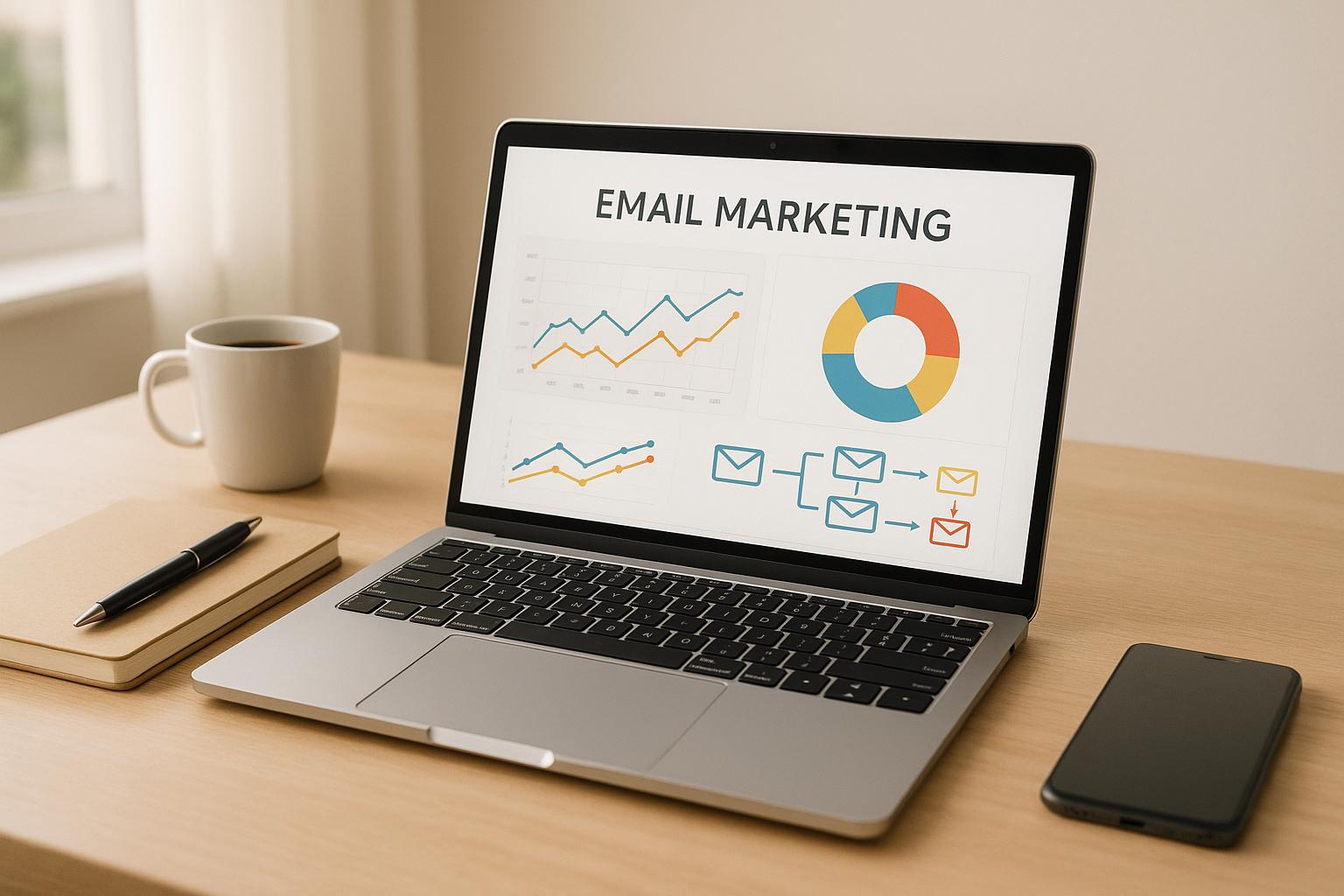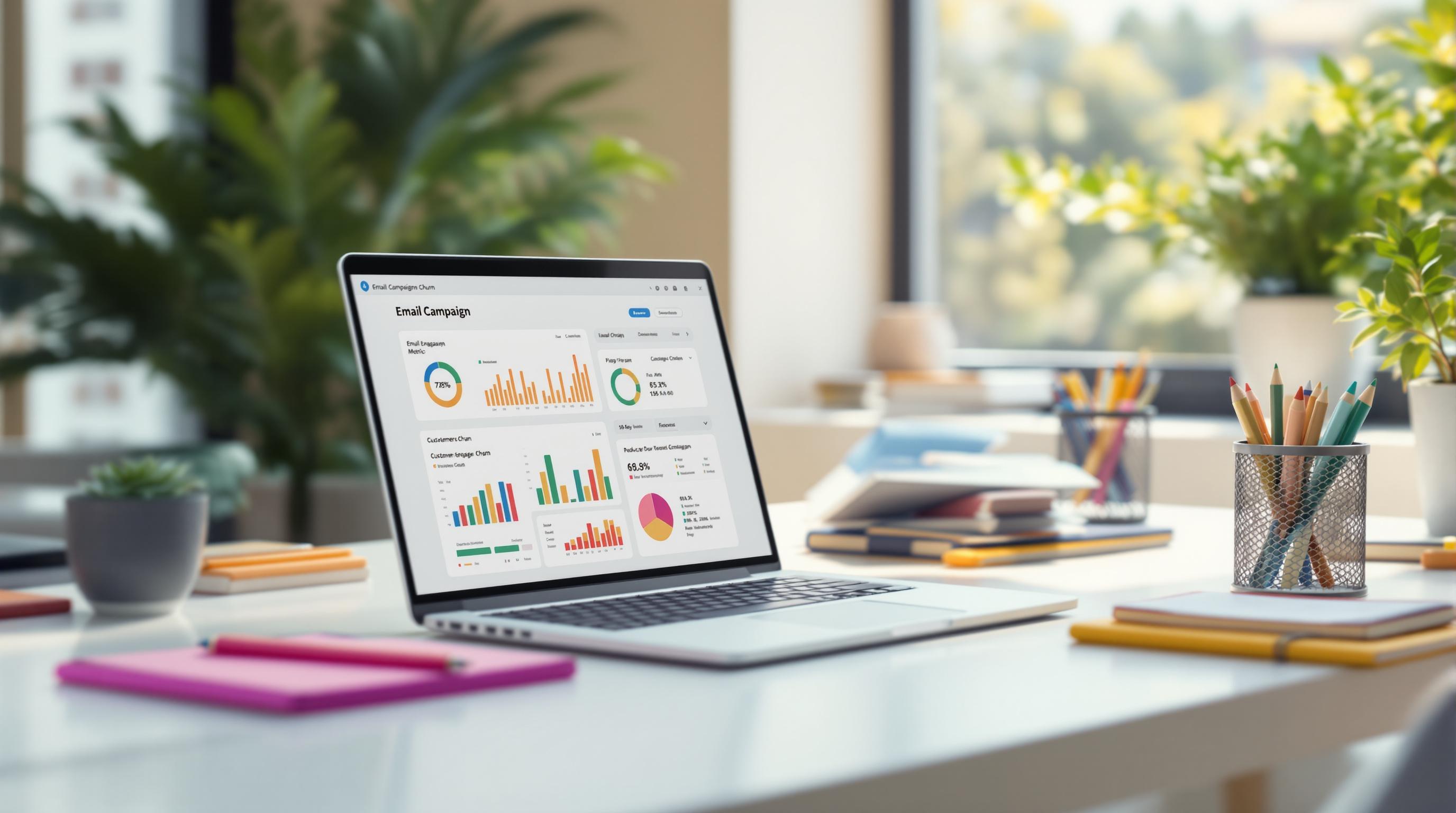Email click-through rate (CTR) is a key metric for measuring how well your email campaigns drive action. In 2025, CTR benchmarks vary significantly by industry, ranging from 0.77% for travel and transportation to 4.36% for hobbies. The average CTR across all industries hovers around 2.62%, with performance heavily influenced by factors like content quality, personalization, segmentation, and timing.
Key Takeaways:
- Why CTR Matters: Unlike open rates, CTR reflects genuine engagement and impacts email deliverability.
- Industry Benchmarks: Hobbies (4.36%), government (4.31%), and media (4.02%) lead CTR performance; travel (0.77%) and marketing (1.11%) lag behind.
- Improving CTR: Focus on personalized content, audience segmentation, A/B testing, and mobile-friendly design.
- Privacy Challenges: With privacy rules limiting traditional metrics like open rates, CTR is now a more reliable indicator of email success.
Quick Overview of 2025 CTR Benchmarks:
| Top Performers | CTR |
|---|---|
| Hobbies | 4.36% |
| Government | 4.31% |
| Media | 4.02% |
| Low Performers | CTR |
|---|---|
| Travel & Transport | 0.77% |
| Marketing | 1.11% |
| Restaurants | 1.13% |
Email CTR benchmarks help businesses set realistic goals and refine strategies to boost engagement. Use these insights to evaluate your campaigns and focus on driving clicks through better segmentation, timing, and tools.
What Are Good Email Marketing Performance Benchmarks? - Marketing and Advertising Guru
2025 Email CTR Benchmarks by Industry
Email engagement rates can differ significantly across industries, shaped by factors like audience preferences, content strategies, and business models. Below are the click-through rate (CTR) benchmarks for key industries in 2025.
CTR Rates Across Different Industries
Here’s a snapshot of CTR benchmarks by sector:
| Industry | Click-Through Rate |
|---|---|
| Government | 4.31% |
| Hobbies | 4.36% |
| Media | 4.02% |
| Non-profit | 3.25% |
| Artist | 3.24% |
| Blogger | 3.23% |
| Art gallery and museum | 3.15% |
| Higher education | 2.80% |
| Author | 2.73% |
| Music and musicians | 2.58% |
| Software and web app | 2.04% |
| Health and fitness | 1.74% |
| Entertainment and events | 1.72% |
| Retail | 1.50% |
| e-commerce | 1.19% |
| Restaurant | 1.13% |
| Marketing and advertising | 1.11% |
| Travel and transportation | 0.77% |
Additional data highlights other benchmarks: B2B services at 2.21%, SaaS companies at 1.91%, hospitality/travel at 2.43%, and IT, tech, and software services at 2.50%. These numbers provide a clear picture of how industries compare in email engagement.
Top and Bottom Performing Industries
Looking at the data, some industries stand out for their strong engagement. Hobbies, government, and media sectors lead the pack with CTRs exceeding 4%, reflecting their ability to connect effectively with their audiences. On the other hand, industries like travel, marketing, and restaurants struggle with lower CTRs, falling below 1.2%.
Several other sectors, including healthcare services (2.70%), financial services (2.50%), construction (3.20%), and real estate (3.60%), land in the mid-range of performance. These figures highlight areas where businesses can refine their email strategies to boost engagement.
As one strategist aptly puts it:
"Good old-fashion click-through rate is one of the most meaningful statistics to track in your email marketing software. This, layered with audience size, can really be the foundation of a list that's ready to be leveraged towards achieving significant business objectives."
With CTRs ranging from 0.77% to 4.36%, these benchmarks emphasize the importance of industry-specific insights when setting realistic email marketing goals. They serve as a valuable guide for businesses aiming to improve their performance and meet audience expectations.
What Affects Email CTR Performance in 2025
Several factors play a critical role in shaping the success of email campaigns in 2025. These factors directly influence the average click-through rates (CTRs) and can help you design campaigns that resonate with your audience and drive meaningful results.
The Role of Content Quality and Personalization
The quality of your content and how well it’s personalized can make or break your email performance. Emails with personalized subject lines see open rates jump by 26% to 50%, while personalized call-to-action (CTA) buttons convert 202% better than standard ones. For example, Williams-Sonoma reported a tenfold increase in responses by tailoring emails to customers' shopping history.
AI-driven personalization takes this further by analyzing user behavior in real time. This approach has shown to increase revenue by 41% and boost CTR by 13.44%. Using dynamic content blocks that adapt to user behavior can drive revenue up by an impressive 760% through segmentation. Even something as simple as including video content in emails can push click-through rates up by 65%. Clearly, personalization isn’t just a nice-to-have - it’s essential for maximizing engagement.
The Impact of Audience Segmentation and Timing
Segmenting your audience ensures that the right message reaches the right person at the perfect moment. Over 90% of marketers report better engagement when they use targeted segmentation. This involves analyzing behavioral data, purchase history, and past interactions. For instance, fitness brands might segment audiences based on workout schedules, while travel companies adjust messaging by time zones to optimize timing.
Speaking of timing, when you send your emails can significantly influence CTRs. With portable devices accounting for 75% of all email opens in the U.S., testing different send times through A/B testing can help pinpoint when your audience is most likely to engage.
Navigating Privacy Rules and Tracking Challenges
Privacy regulations are reshaping how marketers measure email performance. For example, Apple’s Mail Privacy Protection now hides open rates, IP addresses, and location data, making traditional tracking methods less reliable. As a result, marketers are shifting their focus to metrics like click-through rates and conversions. While open rates across industries have climbed to 37.27%, the average CTR holds steady at 2.44%, making it a more dependable metric in today’s privacy-conscious world.
With third-party tracking becoming less effective, collecting first-party data has become a priority. Leading brands are now asking customers directly about their preferences and interests, building trust while gathering insights for better personalization. To comply with privacy standards, marketers are adopting double opt-in processes and permission-based strategies to avoid spam traps. Additionally, offering single-click unsubscribe options gives users more control over their inboxes.
Despite these changes, email remains a powerful tool. In fact, 51% of consumers prefer email as their primary way to interact with brands, and 59% say marketing emails influence their purchasing decisions. The key to success lies in adapting to these evolving dynamics while staying focused on delivering value to your audience.
How to Set CTR Goals for Your Business
To set effective click-through rate (CTR) goals, you’ll need to balance industry benchmarks with your business's unique factors, such as size, audience, and campaign objectives. Combining general averages with your own data will help you create realistic and actionable targets.
Using Benchmarks to Set Targets
Industry benchmarks are a great starting point. For instance, a solid email CTR typically ranges between 2% and 5%. On average, email click rates hover around 2.00% across campaigns, while click-to-open rates vary from 2.93% to 10.71%, depending on the industry.
Your business size and audience type heavily influence CTR expectations. Smaller companies with highly engaged audiences often achieve higher CTRs compared to larger organizations with broader, less targeted email lists. For example, B2B services may experience different engagement dynamics than B2C retail brands, so it’s essential to factor in these nuances.
The type of email campaign also plays a role. A promotional email will likely perform differently from a newsletter or an educational email. A welcome email series, for instance, might achieve higher engagement than a monthly product update.
To establish a realistic baseline, review your campaign data from the past six to twelve months. This analysis will show how your audience has historically interacted with your emails, providing a more accurate benchmark than relying solely on industry averages. For example, if your historical CTR is below the industry standard, setting a goal far above that level might not be practical.
| Industry | Click-Through Rate | Click-to-Open Rate |
|---|---|---|
| Education | 4.4% | 15.7% |
| Real Estate, Design, Construction | 3.6% | 17.2% |
| Agriculture, Forestry, Fishing, Hunting | 3.4% | 12.5% |
| Healthcare Services | 3.0% | 13.4% |
| Government & Politics | 2.8% | 14.3% |
| Average Across All Industries | 2.3% | 10.5% |
| Retail | 0.7% | 5.8% |
This data helps you understand where your performance stands and how to adjust your goals accordingly.
Adding Benchmarks to Your Reports
Incorporating benchmarks into your performance reports gives context to your results. Instead of simply presenting your CTR as a standalone figure, compare it to both industry averages and your own historical performance. This approach creates a clearer narrative and highlights trends that might otherwise go unnoticed.
Create monthly or quarterly reports to track your CTR against these benchmarks. For example, if your CTR consistently beats industry averages but has been declining over time, it could signal an issue worth investigating. Regularly updating these benchmarks ensures they stay relevant as your business grows and as industry conditions evolve.
It’s also important to monitor related metrics alongside CTR, such as bounce rates, unsubscribe rates, and click-to-open rates. These additional data points can help you pinpoint strengths and weaknesses. For instance, a high CTR combined with a high unsubscribe rate might indicate that your emails are engaging but the landing page experience isn’t meeting expectations.
Use these insights to refine your strategy. If your CTR is below industry standards despite strong open rates, consider reworking your email content or calls-to-action. Alternatively, if multiple metrics are underperforming, it might be time to revisit your list segmentation and targeting strategies. By consistently analyzing and adjusting based on these benchmarks, you can set achievable goals and drive better results over time.
sbb-itb-6e7333f
Using Email Service Business Directory to Improve CTRs
Choosing the right email marketing platform can make or break your click-through rate (CTR) performance. The Email Service Business Directory simplifies this task by connecting businesses with platforms designed to increase engagement and encourage more clicks.
How the Directory Helps Choose Platforms
The directory is packed with tools specifically designed to improve CTR. Features like automation, segmentation, and analytics are essential for creating successful email campaigns, and the platforms listed offer these tools in various configurations to meet diverse business needs.
When browsing the directory, prioritize platforms with personalization features. Why? Because personalized content can boost CTR by 39%, while targeted emails have been shown to double CTR. For instance, platforms like SendGrid provide in-depth analytics to fine-tune email performance, while Retainful specializes in automating personalized email sequences tailored for e-commerce.
A/B testing and mobile optimization are also critical. Testing subject lines can increase open rates by 10–15%, and mobile-friendly emails can improve CTR by 15% . Many platforms in the directory include robust testing tools and prioritize mobile-responsive design, ensuring your campaigns are effective across devices. Additionally, segmentation tools stand out as a must-have. By tailoring messages based on customer behavior, segmentation can significantly improve CTR potential.
The directory doesn’t just stop at features - it also categorizes platforms by campaign specialty, making it easier to find tools that align with your specific goals.
Finding Tools for Your Campaign Type
Different campaigns require different tools, and the directory organizes platforms based on their strengths in various areas. For e-commerce businesses, platforms like Retainful are ideal. They focus on challenges like abandoned cart recovery and repeat purchase campaigns, offering features designed to drive clicks for product-focused emails.
B2B companies running lead nurturing campaigns can benefit from tools that excel in drip campaign automation and behavioral triggers. For example, Smartlead.ai offers features like mailbox rotation and AI-driven sequencing for cold email campaigns, ensuring human-like sending patterns that boost engagement.
For enterprise-level operations, the directory spotlights platforms capable of managing large-scale campaigns without sacrificing personalization. These solutions often include advanced segmentation and integration options to maintain consistent branding across all touchpoints.
SaaS companies can explore platforms tailored for onboarding sequences and user engagement campaigns. These tools are designed to address the unique customer journey of software products, offering features to drive clicks at critical conversion stages.
The directory also highlights creative solutions like PostPilot, which bridges email and direct mail. For example, it can send a postcard to a subscriber after they’ve ignored three emails, providing a multi-channel approach to re-engage inactive users.
Another standout option is Salesforge, a platform that combines email finding, verification, sequencing, and inbox rotation, all powered by built-in AI copywriting. This all-in-one approach ensures high deliverability while crafting content that grabs attention and drives clicks.
Conclusion: Improving Email CTRs with Data and Tools
While industry benchmarks like the 2.62% average click-through rate across all industries provide a useful starting point, achieving and surpassing these numbers requires a strategy rooted in accurate data and the right tools. By carefully selecting platforms and employing smart optimization techniques, you can move beyond these averages and make a real impact.
For guidance on finding the right resources, the Email Service Business Directory is a valuable tool. Whether your goal is to meet industry standards or outperform them, this directory connects you with platforms designed to help you succeed.
Consider this: triggered emails can achieve 2.1X higher click rates than standard campaigns. That means automation features should be at the top of your list when evaluating platforms. When paired with robust segmentation and personalization options, these tools can transform your email campaigns into powerful, results-driven assets.
Don’t forget about mobile optimization either. With 85% of users checking emails on their phones, platforms that emphasize mobile-responsive design are non-negotiable. Features like social sharing buttons, which can increase clicks by up to 158%, add even more value, making your emails not just readable but actionable on any device.
FAQs
What are some effective ways for businesses in industries like travel and transportation to improve their email click-through rates?
To improve email click-through rates (CTR) in industries like travel and transportation, it’s all about crafting personalized, visually appealing content. Think high-quality images, exciting travel ideas, and recommendations tailored to your audience’s interests - these elements grab attention and ignite curiosity.
Breaking your audience into segments based on their preferences, past actions, or demographics lets you deliver messages that truly connect. Combine this with clear, action-driven CTAs to guide readers toward their next step. Don’t forget the subject line - it should spark curiosity or excitement to encourage people to open the email in the first place.
Lastly, keep testing and tweaking your campaigns. Experiment with different layouts, sending times, or offers to uncover what resonates most with your audience. Over time, these insights can help you refine your strategy and drive better CTRs.
How can businesses adapt to privacy regulations impacting email marketing metrics in 2025?
To keep up with changing privacy regulations impacting email marketing metrics, businesses should prioritize clear and transparent consent practices. This includes methods like double opt-ins and straightforward, permission-based marketing. Regularly revisiting and updating privacy policies to align with federal and state laws - such as GDPR, HIPAA, or CCPA - is crucial for avoiding legal issues and maintaining customer confidence.
Using privacy-compliant tools and strategies, like anonymized tracking and engagement metrics, allows you to assess campaign performance while safeguarding consumer data. By staying updated on new regulations and focusing on building trust with your audience, your email marketing efforts can thrive well into 2025 and beyond.
How do audience segmentation and timing help improve email click-through rates, and what are some best practices for success?
Why Audience Segmentation and Timing Matter for Email CTR in 2025
When it comes to improving email click-through rates (CTR), two factors stand out: audience segmentation and timing. These elements work hand-in-hand to create emails that feel relevant and arrive at just the right moment.
Audience Segmentation: Make It Personal
Segmenting your audience allows you to send emails that speak directly to specific groups. Whether you sort by demographics, purchase history, or interests, tailoring your messages ensures they resonate more deeply. For example, a fitness brand might send workout gear recommendations to one group and nutrition tips to another. This kind of personalization not only grabs attention but also boosts engagement - leading to more clicks.
Timing: Hit the Sweet Spot
Timing isn’t just about sending emails - it’s about sending them when your audience is ready to engage. Dive into your data to find out when your subscribers are most active. Is it early morning? Mid-afternoon? Late evening? Also, don’t forget to account for time zones, especially if your audience is spread across different regions. Testing various schedules and tracking the results can help you pinpoint the optimal times to hit "send."
The Winning Formula: Combine Segmentation and Timing
When you pair precise audience segmentation with well-timed delivery, you create a personalized experience that feels effortless for the recipient. This combination not only increases the chances of a click but also builds stronger connections with your audience, driving better results for your campaigns.


